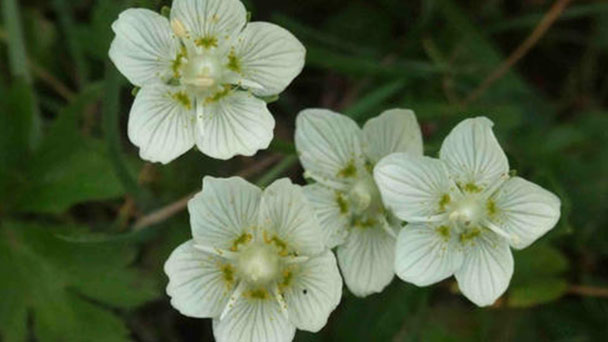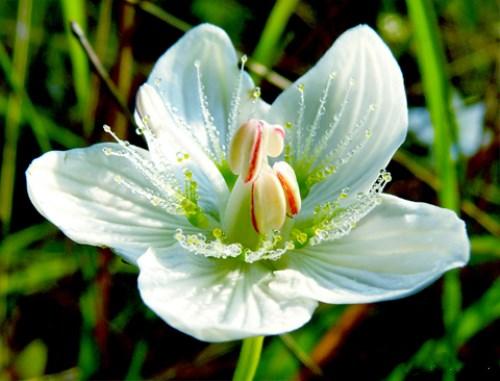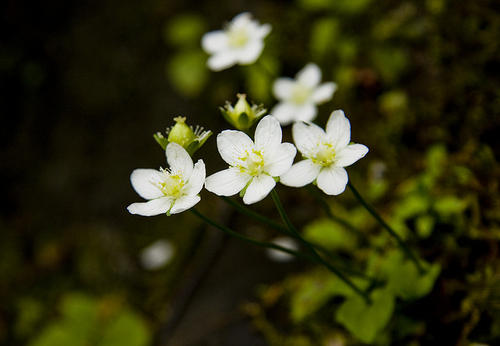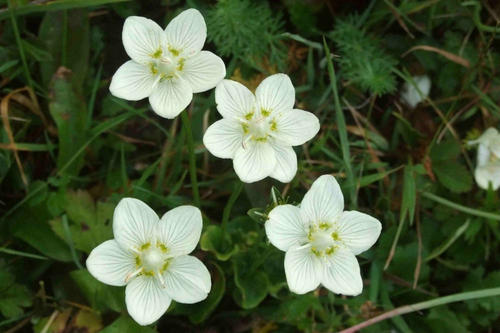Marsh grass of parnassus (Parnassia palustris) profile
Written by Maggie
Mar 08 2021

Marsh grass of parnassus (Parnassia palustris), also known as northern grass-of-Parnassus, or grass-of-Parnassus, is a family of perennial herbs, the height of 50 cm. Marsh grass of parnassus distributes in Northeast China, North China and Shaanxi, Gansu, Qinghai and other places. Marsh grass of parnassus was born in the hillside, forest edge, mountain gully, wetland grassland. The whole grass can be used as medicine, with Qingrejiedu, cough and phlegm effect.
Marsh grass of parnassus on a rocky cliff. The smell is sweet and bitter. Marsh grass of parnassus creat women blood collapse blood clots, disperse gas, meridian benefit water;C old pain in the stomach and internal hernia disappear. Food retention into the new, hard pain, suit made Chai.
Marsh grass of parnassus picture

Morphological characteristics of Marsh grass of parnassus
Rhizome
Marsh grass of parnassus is a perennial herb with a height of 50 cm. Rhizome is short and stout, occasionally slightly older, with many slender fibrous and whisker roots below, with remnants of brown membranous scales above. Marsh grass of parnassus has 2-4 stems, usually with 1 cauline leaf near the middle, cauline leaves homomorphic to basal leaves, often with rust-colored appendages at base, sessile and semicircular.
Leaf
Marsh grass of parnassus basal leaves are 3 to many, stipitate; Leaf blade ovate to oblong-ovate, occasionally triangular-ovate, 1.5-3 cm long, 1-2.5 cm wide, apex obtuse or acuminate, often with brachycarpus, base subcordate, margin entire, thin and slightly curling outward, dark green above, pale green below, often spotted with purple oblong, veins 5-7 near base, curved, more pronounced below; Petiole of Marsh grass of parnassus is 3-6 (-8) cm long, flanked by narrow wings, with long purple spots; Stipules are membranous, mostly attached to the petiole, edge has brown fringed hairs, caducous.
Flowers
Flowers of Marsh grass of parnassus are solitary at stem apex, 2.2-3 (-3.5) cm in diameter; Sepals are elliptic or oblong, apex obtuse, entire, with 7-9 veins, densely spotted purple-brown; Petals are white, broadly ovate or obovate, 1 -- 1.5 (-1.8) cm long, 7 -- 10 (-13) mm wide, apex obtuse or shortly acuminate, base with broad and short claws, entire, with prominent 7 -- 13 veins from base, often spotted purple;Stamens 5, filaments flat, unequal in length, up to 7 mm long, up to 2.5 mm short, gradually broadened toward the base, anthers elliptic, ca. 3 mm long; Marsh grass of parnassus has 5 stamen, up to 1 m long, branched, with a distinct trunk, about 2.5 mm in the trunk, branches of varying length, 3-4 times longer in the middle, shorter on both sides, usually (7-) 9-11 (-13) branches, with globular glands at the tip of each branch; Ovary is superior, ovoid, style very short, stigma 4-lobed.
Fruit
The capsule of Marsh grass of parnassus is ovoid, with purplish brown spots after drying and 4-petal dehiscence. Seeds are numerous, oblong, brown, lustrous.
The ecological habits of the Marsh grass of parnassus
Marsh grass of parnassus grows on damp hillsides, in damp places near gullies or river valleys, at an altitude of 1580 -- 2000 m. Marsh grass of parnassus was a born in the hillside, forest edge, mountain gully, wetland grassland.
The Marsh grass of parnassus distribution
Marsh grass of parnassus is grown in Xinjiang (Tori, Baicheng, Qinghe and Fuhai).
Marsh grass of parnassus is distributed in Northeast China, Hebei, Shanxi, Shaanxi, Gansu, Inner Mongolia and other places. It is also found in Europe, temperate Asia and North America.
Marsh Grass of Parnassus type specimens were collected from Europe.

Taxonomy of Marsh grass of parnassus
Multiple branches of Marsh grass of Parnassus (Variety) parnassia palustris L. var. multiseta Ledeb.
The main difference between this variety and the original variety is that the stamens are more branched, (11-) 13-23, longer than the stamens and slightly shorter than the petals.Flowering plants are taller, basal leaves are missing or less and smaller.
Produced in Heilongjiang, Jilin, Liaoning, Inner Mongolia, Hebei, Shanxi and Shaanxi-Gansu Basin.It is born on slopes, gullies, rivers, grasslands and roadsides, and is 1250-2220 meters above sea level.It is also found in Korea, Japan, Amur region, Ussuri and Dauri. The type specimens were collected from Russia (Siberia).
Parnassia palustris L. var. palustris form. Nana T. C. Ku
The main difference between this variant and the original is that the plant is short and no more than 5 cm high. Petal margin not obviously rodent; Staminodes 7-9.
Xinjiang (Tacheng).The type specimens were collected from Tacheng.
The Marsh grass of parnassus is a Marsh grass of parnassus. The Marsh grass is a Marsh grass of parnassus
Herbs are perennial, 12-20 (-30) cm tall. Rhizome short and stout, occasionally slightly older, with many slender fibrous and whisker roots below, with remnants of brown membranous scales above. Basal leaves 3 to many, stipitate;Leaf blade ovate to oblong-ovate, occasionally triangular-ovate, 1.5-3 cm long, 1-2.5 cm wide, apex obtuse or acuminate, often with brachycarpus, base subcordate, margin entire, thin and slightly curling outward, dark green above, pale green below, often spotted with purple oblong, veins 5-7 near base, curved, more pronounced below; Petiole 3-6 (-8) cm long, flanked by narrow wings, with long purple spots; Stipules membranous, mostly attached to the petiole, edge has brown fringed hairs, caducous.
Stems 2-4, usually with 1 cauline leaf near the middle, cauline leaves are homomorphic to basal leaves, often with rust-colored appendages at base, sessile and semicircular. Flowers solitary at stem apex, 2.2-3 (-3.5) cm in diameter; Sepals elliptic or oblong, apex obtuse, entire, with 7-9 veins, densely spotted purple-brown; Petals white, broadly ovate or obovate, 1 -- 1.5 (-1.8) cm long, 7 -- 10 (-13) mm wide, apex obtuse or shortly acuminate, base with broad and short claws, entire, with prominent 7 -- 13 veins from base, often spotted purple; Stamens 5, filaments flat, unequal in length, up to 7 mm long, up to 2.5 mm short, gradually broadened toward the base, anthers elliptic, ca. 3 mm long; Stamen 5, up to 1 m long, branched, with a distinct trunk, about 2.5 mm in the trunk, branches of varying length, 3-4 times longer in the middle, shorter on both sides, usually (7-) 9-11 (-13) branches, with globular glands at the tip of each branch; Ovary superior, ovoid, style very short, stigma 4-lobed. Capsule ovoid, dry after purplish brown spots, was 4 petals dehiscence; Seeds numerous, oblong, brown, lustrous.
How to grow and care for Marsh grass of parnassus
1. Marsh grass of parnassus likes to grow at a temperature of 15-30°, and it is also very resistant to high temperatures in summer. In winter, it is required to be not less than 5°, otherwise it is susceptible to cold and leaves.Although this plant is fond of warm and humid climate, but also high temperature resistance is not cold, but want to raise very careful care.
2. Marsh grass of parnassus is a positive plant that likes light.In the growing season if it is not given enough light, it is easy to lead to the plant's weak growth, thus affecting the bud and flowering. Therefore, except when it is still a seedling, it should be given sufficient light for all its growth. Winter must not be less than 8 hours, otherwise prone to a large number of fallen leaves. Limit light exposure to about nine hours a day, and the buds will bloom after a month and a half.
3. Marsh grass of parnassus likes to grow in fertile and slightly acidic soil, usually potted when you can use some leaf rot soil, or peat soil and add a small amount of stale cake slag to mix as a base fertilizer, conducive to its growth. Turn the pot and change the soil once a year after flowering.

Latest Updated
- Benefits of Bugleweed - 7 Science-backed Health Benefits
- Bugleweed Dangers & Side Effects - Is It Poisonous?
- How to Plant Evergreen Trees - What You Should Know
- When to Plant Evergreens - Grow Guide for Evergreen Trees
- 12 Wonderful Evergreen Shrubs for Your Garden
- 12 Popular Evergreen Plants with Pictures for Beginners
- When And How To Prune A Lilac Bush Like a Pro
- How to Grow & Care for Lilac Vine (Hardenbergia Violacea)
- Japanese Lilac Tree (Syringa Reticulata) Care & Propagation Guide
- Shumard Oak Pros and Cons - What to Know
Popular Articles
- Winter maintenance of Antirrhinum Majus
- How to Grow Terminalia Mantaly Tree
- How to Grow and Care for Crossostephium Chinense
- How to grow Antirrhinum Majus in spring
- Peristeria Elata (Dove Orchid) Profile: Info & Care Guide
- Underwatered Snake Plant (Sansevieria Trifasciata) - Signs And How To Fix
- How to Care for Brazilian Jasmine Plant (Mandevilla Sanderi)
- How to Grow & Care for Graptopetalum Purple Delight in Summer
- Rosa Chinensis (China Rose): Plant Growing & Care Tips
- How to Care for Baby Sun Rose (Aptenia Cordifolia)